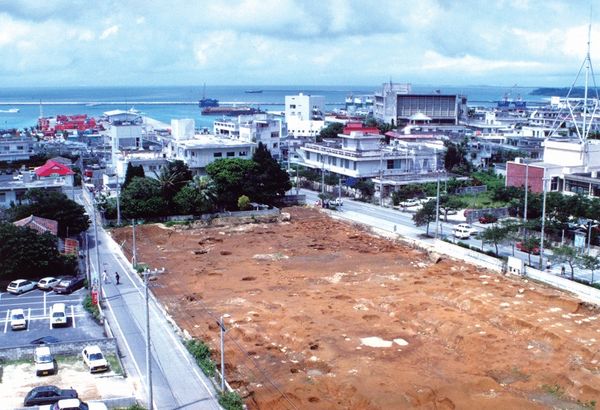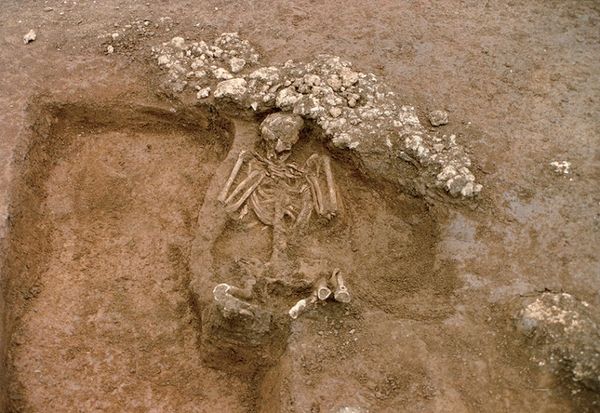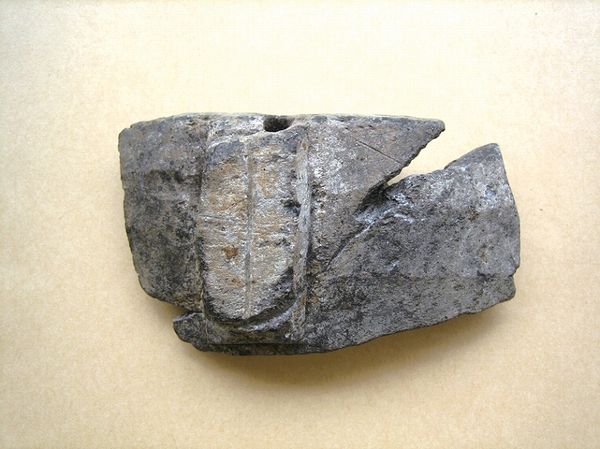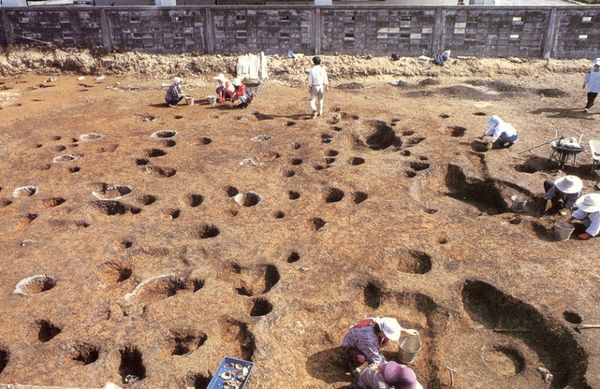トップ > 市の組織 > 教育委員会 > 生涯学習部 > 生涯学習振興課 > 【市指定史跡】 住屋遺跡(俗称・尻間)
【市指定史跡】 住屋遺跡(俗称・尻間)

発掘調査時の遺跡全景
Panoramic view of the remains during the excavation survey

人骨(15世紀〜16世紀)
Human remains (15C - 16C)

長崎産滑石製石鍋の破片(11世紀後半〜12世紀)
A fragment of stone pot made of lime stone from Nagasaki (Late 11C - 12C)
〔すみやいせき(ぞくしょう・しいま)〕
住屋遺跡は、概ね14~17世紀初期頃の集落跡である。1982(昭和57)年2回にわたる発掘調査の結果、14世紀頃と推定される竪穴住居址1基と16~17世紀初期と推定される平地住居址・石敷住居址・円形状建物跡・竪穴炉址・溜井戸等の遺構を検出。
遺物では、土器片・石器(石錘・たたき石)・貝製品(貝錘・貝さじ)・鉄製品(刀子・短刀・くぎ)・古銭(熙寧元宝・無文銭)・ガラス玉・炭化麦・米、獣魚骨・貝殻等が出土している。
このように同一遺跡で竪穴―平地―石敷住居址と、年代差を明瞭に示した遺構等が検出されるのは稀であり、当時の人々の生活様式や住居形態の変遷を知る上で重要な遺跡である。
この地は1629(崇禎2)年に在番仮屋(ざいばんかいや)が設けられた場所でもある。在番とは島役人の指導・監督のため琉球王府が派遣した役人のことで、普通2年交替で在勤、その滞在中の宿舎を在番仮屋と称していた。
1879(明治12)年3月の廃藩置県直後には警視派出所が設けられて県政がスタートしたがその後、宮古島役所が開設されるにともなって、役所長官舎・支庁長官舎・宮古民政府知事公舎・宮古群島政府知事公舎・琉球政府宮古地方長公舎として重用されてきた。
上記のように当史跡は14~17世紀初期の集落遺跡として、また、旧藩時代から近代に至る政治の中心として、直接民衆にかかわる諸制度の変遷を知る上でも重要な史跡である。
【Historic Site Designated by the City】 Sumiya Remains (Known as Shiima)
The Sumiya Remains is a former settlement site from around the 14th to the 17th century. As a result of the two excavations that took place in 1982, one pit dwelling from the 14th century was discovered. Also unearthed were ground-level dwelling, stone-laid dwelling, circular building remains, firepit, water well, and other remains.
Unearthed relics include pieces of pottery, stoneware (weights and hammers), shell goods (weights and spoons), iron goods (small knives, short swords, nails), old coins (Kineigenpo and Mumonsen), glass marbles, carbonized grains and rice, animal and fish bones, shells, etc.
It is rare to find various types of dwellings in the same site where the age is very clear, which makes this site an important one to understand how the people lived in the past, and how their styles of homes changed over time.
This location is also where the Zaiban Kaiya was located in 1629. A Zaiban is an official dispatched by the royal government of Ryukyu, to direct and oversee the officials on the island. They came in two-year rotations and the place where they stayed while dispatched here, was They came in two-year rotations and the place where they stayed while dispatched here, was called the Zaiban Kaiya.
Immediately after the abolition of the feudal domain in March of 1879, a police station was placed here and saw the start of the prefectural government. Later, the Miyakojima public office was established, and the location played an important role as official residences for the chief of the government office, chief of the branch office, governor of the Miyako civilian administration, governor of the Miyako Islands administration, and as the official residence of the chief of the Miyako district under the Ryukyu government.
As mentioned above, the location is an important historical site as a former site of settlement for the people dating back to the 14th to the 17th centuries, and as the heart of politics from the former era of feudal domain to the present, it helps us to understand the changes in the government system which directly relates to the people of Miyako.
【市指定史跡】 住屋遺跡(俗稱:尻間)
住屋遺跡是大概在14~17世紀初期的村落遺跡。根據1982年(昭和57年)的两次挖掘調查結果,發現14世紀左右的竪坑式住居遺阯1座和16~17世紀初期的平地住居遺阯・石板住居遺阯・「圓形建築遺跡」・竪坑式爐遺阯・雨水井等遺跡。
出土的遺物中,有陶器碎片、石器(石錘、敲擊石)、貝殼製品(貝錘、貝匙)、鐵製品(刀子、短刀、釘子)、古錢(熙寧元寶、無文錢)、玻璃球、炭化麥・米、獸魚骨、貝殼等,
像這樣在同一個遺跡上,出現竪坑―平地―石板住居遺阯,以及年代差別明顯的遺物實屬少見,是瞭解當時人們的生活方式和居住形態變遷的重要遺跡。
這個地方在1629年(崇禎2年),還是在番假屋(臨時小屋)的所在地。在番是琉球王府為了指導和監督島上官員所派遣的官員,一般每两年輪調一次赴任,滯留期間的宿舍稱為在番假屋。
1879年(明治12年)3月的廢藩置縣後不久,設立了警視派出所並開始了縣政。但是,後來隨著宮古島政府的開設,先後做為政府長官舍、分廳長官舍、宮古民政府知事公舍、宮古群島政府知事公舍、琉球政府宮古地方長公舍而受到重用。
如上所述,該歷史遺跡做為14~17世紀初期的村落遺跡,以及從舊番時代直到近代的政治中心,是瞭解直接與民眾相關的各種制度變遷的重要歷史遺跡。
【미야코지마시 지정 사적】 스미야 유적 (속칭, 시이마)
스미야 유적은 대강 14-17세기 초기 경의 마을 유적이다.
1982년 두 번에 걸친 발굴 조사 결과, 14세기 경으로 추정되는 수혈식 주거 유적지 1기와 16-17세기 초기로 추정되는 평지 주거 유적지, 포석 주거 유적지, 원형상태의 건물 유적지, 수혈로 우물 등 옛 건축의 잔존물이 검출되었다. 유물로는 토기 조각, 석기(돌추, 맷돌), 조개류 제품(조개 추, 조개 숟가락), 철제품(작은 칼, 단도,못), 옛 동전(기네이겐포, 무몬센), 유리구슬, 탄화 보리, 쌀, 짐승뼈, 조개 껍데기 등이 출토되었다. 이처럼 동일 유적에서 수혈-평지-포석 주거 유적이 연대차를 보이면서 명료하게 옛 건축의 잔존물이 검출되는 것은 드문 일이다. 당시 사람들의 생활 양식이나 주거 형태의 변천을 이해하는데 중요한 유적이다.
이 땅은 1629년에 자이반카이야가 설치된 장소이기도 하다. 자이반이란 섬을 지도 감독하기 위해 류큐 왕부가 파견한 관리직을 말한다. 보통 2년을 임기로 교체 근무하였다. 체류 중에 사용했던 기숙사는 자이반카이야라고 불렸다. 1879년 3월에 번을 폐지하고 현을 배치한 직후에는 파출소가 설치되어 오키나와현 체제의 정치가 시작되었다.
그 후 미야코섬 관리부서가 개설됨에 따라 청장관사, 지청장관사, 미야코민정부지사공사, 미야코군도정부지사공사,류큐정부미야코지방장공사로써 중용되었다.
위와 같이 이 사적은 14-17세기 초기의 마을 유적으로써, 구 번시대부터 근대에 이르는 정치의 중심으로써 민중의 삶과 직접 관련되는 여러 제도의 변천을 파악하는데 있어 중요한 사적이다.
生涯学習部 生涯学習振興課
電話:0980-72-3764






